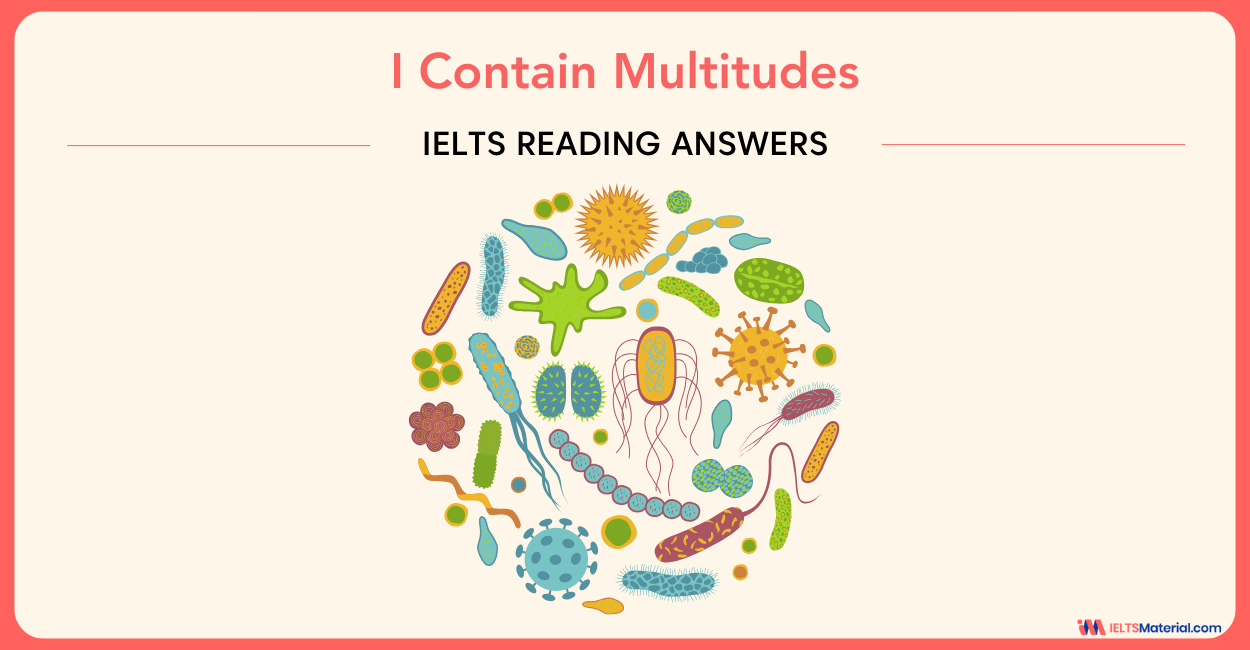Biology of Bitterness Reading Answers
13 min read
Updated On
-
Copy link
Table of Contents

Limited-Time Offer : Access a FREE 10-Day IELTS Study Plan!
The ‘Biology of Bitterness’ is an IELTS Academic Reading passage is a good resource for anyone who is preparing for the IELTS Reading test. This passage will help you understand what kind of reading passages you will encounter and the questions that you will be asked to solve.
The question types in this ELTS Reading Passage include:
- Reading Matching Headings (Q1 – Q8)
- Reading Summary Completion (Q9 – Q14)
Reading Passage
| You should spend about 20 minutes on questions 1-14, which are based on the Reading Passage below. |
Biology of Bitterness
To many people, grapefruit is palatable only when doused in sugar. Bitter Blockers like adenosine monophosphate could change that.
A. There is a reason why grapefruit juice is served in little glasses: most people don’t want to drink more than a few ounces at a time. Naringin, a natural chemical compound found in grapefruit, tastes bitter. Some people like that bitterness in small doses and believe it enhances the general flavor, but others would rather avoid it altogether. So juice packagers often select grapefruit with low naringin though the compound has antioxidant properties that some nutritionists contend may help prevent cancer and arteriosclerosis.
B. It is possible, however, to get the goodness of grapefruit juice without the bitter taste. I found that out by participating in a test conducted at the Linguagen Corporation, a biotechnology company in Cranbury, New Jersey. Sets of two miniature white paper cups, labeled 304 and 305, were placed before five people seated around a conference table. Each of us drank from one cup and then the other, cleansing our palates between tastes with water and a soda cracker. Even the smallest sip of 304 had grapefruit ‘s unmistakable bitter bite. But 305 was smoother; there was the sour taste of citrus but none of the bitterness of naringin. This juice had been treated with adenosine monophosphate, or AMP, a compound that blocks the bitterness in foods without making them less nutritious.
C. Taste research is a booming business these days, with scientists delving into all five basics-sweet, bitter, sour, salty, and umami, the savory taste of protein. Bitterness is of special interest to industry because of its untapped potential in food. There are thousands of bitter -tasting compounds in nature. They defend plants by warning animals away and protect animals by letting them know when a plant may be poisonous. But the system isn’t foolproof. Grapefruit and cruciferous vegetables like Brussels sprouts and kale are nutritious despite-and sometimes because of-their bitter-tasting components. Over time, many people have learned to love them, at least in small doses. “Humans are the only species that enjoys bitter taste,” says Charles Zuker, a neuroscientist at the University of California School of Medicine at San Diego. “Every other species is averse to bitter because it means bad news. But we have learned to enjoy it. We drink coffee, which is bitter, and quinine [in tonic water] too. We enjoy having that spice in our lives.” Because bitterness can be pleasing in small quantities but repellent when intense, bitter blockers like AMP could make a whole range of foods, drinks, and medicines more palatable-and therefore more profitable.
D. People have varying capacities for tasting bitterness, and the differences appear to be genetic. About 75 percent of people are sensitive to the taste of the bitter compounds phenylthiocarbamide and 6-n-propylthiouracil. and 25 percent are insensitive. Those who are sensitive to phenylthiocarbamide seem to be less likely than others to eat cruciferous vegetables, according to Stephen Wooding, a geneticist at the University of Utah. Some people, known as supertasters, are especially sensitive to 6-n-propylthiouraci because they have an unusually high number of taste buds. Supertasters tend to shun all kinds of bitter-tasting things, including vegetables, coffee, and dark chocolate. Perhaps as a result, they tend to be thin. They’re also less fond of alcoholic drinks, which are often slightly bitter. Dewar’s scotch, for instance, tastes somewhat sweet to most people. ” But a supertaster tastes no sweetness at all, only bitterness,” says Valerie Duffy, an associate professor of dietetics at the University of Connecticut at Storrs.
E. In one recent study, Duffy found that supertasters consume alcoholic beverages, on average, only two to three times a week, compared with five or six times for the average nontasters. Each taste bud, which looks like an onion, consists of 50 to 100 elongated cells running from the top of the bud to the bottom. At the top is a little clump of receptors that capture the taste molecules, known as tastants, in food and drink. The receptors function much like those for sight and smell. Once a bitter signal has been received, it is relayed via proteins known as G proteins. The G protein involved in the perception of bitterness, sweetness, and umami was identified in the early 1990s by Linguagen’s founder, Robert Margolskee, at Mount Sinai School of Medicine in New York City. Known as gustducin, the protein triggers a cascade of chemical reactions that lead to changes in ion concentrations within the cell. Ultimately, this delivers a signal to the brain that registers as bitter. “The signaling system is like a bucket brigade,” Margolskee says. “It goes from the G protein to other proteins.”
F. In 2000 Zuker and others found some 30 different kinds of genes that code for bitter-taste receptors. “We knew the number would have to be large because there is such a large universe of bitter tastants,” Zuker says. Yet no matter which tastant enters the mouth or which receptor it attaches to, bitter always tastes the same to us. The only variation derives from its intensity and the ways in which it can be flavored by the sense of smell. “Taste cells are like a light switch,” Zuker says. “They are either on or off.”
G. Once they figured out the taste mechanism, scientists began to think of ways to interfere with it. They tried AMP, an organic compound found in breast milk and other substances, which is created as cells break down food. AMP has no bitterness of its own, but when put in foods, Margolskee and his colleagues discovered, it attaches to bitter-taste receptors. As effective as it is, AMP may not be able to dampen every type of bitter taste, because it probably doesn’t attach to all 30 bitter-taste receptors. So Linguagen has scaled up the hunt for other bitter blockers with a technology called high-throughput screening. Researchers start by coaxing cells in culture to activate bitter-taste receptors. Then candidate substances, culled from chemical compound libraries, are dropped onto the receptors, and scientists look for evidence of a reaction.
H. In time, some taste researchers believe, compounds like AMP will help make processed foods less unhealthy. Consider, for example, that a single cup of Campbell’s chicken noodle soup contains 850 milligrams of sodium chloride, or table salt-more than a third of the recommended daily allowance. The salt masks the bitterness created by the high temperatures used in the canning process, which cause sugars and amino acids to react. Part of the salt could be replaced by another salt, potassium chloride, which tends to be scarce in some people’s diets. Potassium chloride has a bitter aftertaste, but that could be eliminated with a dose of AMP. Bitter blockers could also be used in place of cherry or grape flavoring to take the harshness out of children’s cough syrup, and they could dampen the bitterness of antihistamines, antibiotics, certain HIV drugs, and other medications.
I. A number of foodmakers have already begun to experiment with AMP in their products, and other bitter blockers are being developed by rival firms such as Senomyx in La Jolla, California. In a few years, perhaps, after food companies have taken the bitterness from canned soup and TV dinners, they can set their sights on something more useful: a bitter blocker in a bottle that any of us can sprinkle on our brussels sprouts or stir into our grapefruit juice.
Biology of Bitterness IELTS Reading Questions
Questions 1-8
The reading Passage has seven paragraphs A-I.
Which paragraph contains the following information?
Write the correct letter A-I, in boxes 1-8 on your answer sheet.
1 Experiment on bitterness conducted
2 Look into the future application
3 Bitterness means different information for human and animals
4 Spread process of bitterness inside of body
5 How AMP blocks bitterness
6 Some bitterness blockers may help lower the unhealthy impact
7 Bitterness introduced from a fruit
8 Genetic feature determines sensitivity
Question 9-12
Summary
The reason why grapefruit tastes bitter is because a substance called 9 ___________ contained in it. However, bitterness plays a significant role for plants. It gives a signal that certain plant is 10 ___________. For human beings, different person carries various genetic abilities of tasting bitterness. According to a scientist at the University of Utah,11 ___________ have exceptionally plenty of 12 ___________which allows them to perceive bitter compounds.
Questions 13-14
Choose the correct letter, A, B, C or D.
Write your answers in boxes 13-14 on your answer sheet.
13 What is the main feature of AMP according to this passage?
A Offset bitter flavour in food
B Only exist in 304 cup.
C Tastes like citrus.
D Chemical reaction when meets biscuit.
14 What is the main function of G protein?
A Collecting taste molecules.
B Identifying different flavours elements.
C Resolving large molecules.
D Transmitting bitter signals to the brain.
Want to improve your IELTS Academic Reading score? Grab Our IELTS Reading Ebook Today!
Biology of Bitterness IELTS Reading Answers
1 Answer: B
Question type: Matching paragraph information
Answer location: Paragraph B, lines 2-3
Answer explanation: This paragraph talks in detail about a test (experiment) on bitterness that was conducted at the Linguagen Corporation, a biotechnology company in Cranbury, New Jersey. Five participants were given two cups labelled 304 and 305. The experiment provided the participants two cups of grapefruit juice, one with a compound added and the other without, to see how the compound altered the bitter taste of grapefruit juice. Hence, the answer is B.
2 Answer: I
Question type: Matching paragraph information
Answer location: Paragraph I, lines 1-4
Answer explanation: This paragraph explores the scope of future application of AMP and alternative bitterness blockers are being developed by rival companies. It is mentioned that in a few years (future), perhaps, after food companies have taken the bitterness from canned soup and TV dinners, they can set their sights on something more useful. Hence, the answer is B.
3 Answer: C
Question type: Matching paragraph information
Answer location: Paragraph C, lines 7-9
Answer explanation: While every other species is averse to bitter because it means bad news, only humans have learned to enjoy the taste of bitterness, at least in small doses. Hence, the answer is C.
4 Answer: E
Question type: Matching paragraph information
Answer location: Paragraph E, lines 5-11
Answer explanation: This paragraph talks about how bitterness spreads within the body. The bitter taste is first picked up by the receptor cells on the tongue which are relayed by G proteins or gustducin which triggers chemical reactions that finally reaches the brain. Hence, the answer is E.
5 Answer: G
Question type: Matching paragraph information
Answer location: Paragraph G, lines 3-4
Answer explanation: AMP by itself has no bitterness but when added to bitter foods, researchers found that it attaches to the bitter taste receptors and blocks it. Hence, the answer is G.
6 Answer: H
Question type: Matching paragraph information
Answer location: Paragraph H, lines 1-2
Answer explanation: Some taste researchers opine that compounds such as AMP will enable processed foods such as canned soup to be less unhealthy. The addition of potassium chloride, which is lacking in some people’s diets, to canned soup will be more beneficial than sodium chloride. However, AMP will also need to be added to ensure that potassium chloride does not taste bitter when people are consuming the soup. Hence, the answer is H.
7 Answer: A
Question type: Matching paragraph information
Answer location: Paragraph A, line 2
Answer explanation: This paragraph talks about grapefruit naturally being a source of bitterness. Grapefruit is one fruit that contains bitterness due to the presence of a substance called naringin that is naturally present in it and contributes to its bitter taste. Hence, the answer is A.
8 Answer: D
Question type: Matching paragraph information
Answer location: Paragraph D, line 1
Answer explanation: This paragraph deals with the genetic differences in sensitivity to bitterness. Approximately 75 percent of all people display a sensitivity to bitter compounds namely, phenylthiocarbamide and 6-n-propylthiouracil while the remaining 25 percent are not sensitive. So, genes determine who acquires this sensitivity and who does not. Hence, the answer is D.
9 Answer: Naringin
Question type: Summary completion
Answer location: Paragraph A, line 2
Answer explanation: The reason behind the naturally occurring bitter taste of grapefruit is the presence of a compound known as naringin. Those who package grapefruit juice thus often select those fruits which are low in naringin. However, experts suggest that naringin has beneficial effects such as helping to prevent cancer and atherosclerosis. Hence, the answer is naringin.
10 Answer: Poisonous
Question type: Summary completion
Answer location: Paragraph C, line 5
Answer explanation: Bitterness works differently in humans and other species. Specifically, in animals, bitter tastes let them know a plant is poisonous and should not be consumed. Hence, the answer is poisonous.
11 Answer: Supertasters
Question type: Summary completion
Answer location: Paragraph D, line 6
Answer explanation: According to Stephen Wooding, a geneticist at the University of Utah, there are some people who are sensitive to phenylthiocarbamide and seem to be less likely than others to eat cruciferous vegetables.Some people, known as supertasters, are especially sensitive to 6-n-propylthiouracil and such people are extra sensitive to bitter foods and shun them. Hence, the appropriate answer is supertasters.
12 Answer: Tastebuds
Question type: Summary completion
Answer location: Paragraph D, line 7
Answer explanation: The reason behind supertasters shunning virtually all bitter foods is that they have an exceptionally greater number of taste buds in comparison to others which makes them more sensitive to bitter tastes such as coffee, dark chocolate, and certain vegetables. Hence, the answer is tastebuds.
13 Answer: A
Question type: Multiple choice questions
Answer location: Paragraph B, lines 7-8
Answer explanation: It is mentioned that an experiment conducted by Linguagen Corporation in New Jersey showed that adenonsine monophosphate or AMP was able to reduce the bitterness prevalent in grapefruit juice. It alters the taste of bitter foods by blocking the bitter receptors. Hence, the answer is A.
14 Answer: D
Question type: Multiple choice questions
Answer location: Paragraph E, line 11
Answer explanation: G proteins were identified in the early 1990s and it is known to trigger a cascade of chemical reactions that lead to changes in ion concentrations within the cell and this transmits a signal to the brain which conveys the taste of bitterness. Hence, the answer is D.
Tips for Answering the Question Types in Biology of Bitterness IELTS Reading Answers
Now let’s get started with the tips for each question type. It’ll help you understand how to approach the problem of each question type.
Matching Heading
In order to solve this question type, we’ve provided some important tips that will help you to break down the questions of ‘Matching Headings’ accordingly to solve it. Check out the tips below:
- Read the instructions carefully: Before you start, make sure you understand what you need to match. Sometimes, you’ll be asked to match headings to paragraphs or statements to sections, so be clear on the task.
- Skim the passage: Quickly read through the passage to get a general sense of the content and layout. This will help you identify where the information you need might be located.
- Use keywords: Look for keywords or key phrases in the question and the passage. These words are often repeated or paraphrased in the text and can guide you to the correct answer.
- Underline or highlight: As you find information that matches the question, underline or highlight it in the passage. This will make it easier to refer back to when answering the questions.
- Check for synonyms: Be aware of synonyms and paraphrases. Sometimes, the exact words from the question may not appear in the passage, but similar words or phrases will. Keep an eye out for these.
Summary Completion
Fill in the sentences with keywords hidden in the reading passages with the following tips as they’ll come in handy for your preparation.
- Read the sentence carefully: Begin by reading the sentence with the gap or blank. Try to understand the context and the type of word that should fit the gap (e.g., noun, verb, adjective).
- Look for clues: Scan the surrounding sentences for clues that can help you determine the missing word. Sometimes, the sentence structure or the words nearby can provide hints.
- Identify grammatical clues: Pay attention to the grammar of the sentence. If the sentence requires a verb, make sure you choose a verb form that fits the context. The same goes for nouns, adjectives, and other parts of speech.
- Use your vocabulary: Draw on your vocabulary to come up with a suitable word for the gap. Ensure that the word you choose makes sense in the context of the sentence.
- Check for coherence: After you’ve filled in the gap, read the entire sentence to ensure that it flows naturally and makes sense. The completed sentence should be grammatically correct and logically coherent.
Check More IELTS Reading Answers
Practice IELTS Academic Reading based on question types

Start Preparing for IELTS: Get Your 10-Day Study Plan Today!
Recent Articles

Kasturika Samanta

Nehasri Ravishenbagam

Nehasri Ravishenbagam

Kasturika Samanta




Post your Comments